How many guitar picks have you cycled through in your quest for the perfect sound and feel? From the slickness of Clayton 1.0 mm picks to the attack of Dunlop Stubby Jazz picks (before grip became an issue with sweaty hands), the journey can be extensive. Novelty rubber picks, flexible nylon, textured grip picks, and picks of varying thicknesses – many guitarists have explored them all.
Eventually, many players narrow their search to a specific brand and material. For years, Dunlop Tortex picks have been a favorite for countless guitarists. Experimenting with gauges like .66mm, .73mm, and .83mm often leads to settling on a preferred thickness – in my case, the .83mm, favored for its balanced tone and comfortable feel. The green color and the iconic turtle logo are just added bonuses.
For a long time, this felt like the end of the pick journey. However, watching a video featuring Nick Hipa of As I Lay Dying, I discovered a new dimension to pick selection. Hipa mentioned his preference for the M3 (Jazz III size) version of the .88mm green Tortex, specifically highlighting the enhanced picking accuracy offered by its sharper tip.
This revelation was a game-changer. Previously, my pick choices were primarily driven by tone and grip. The concept of “picking accuracy” hadn’t been a central consideration. Intrigued, I made the switch and quickly realized the significance of this often-overlooked aspect. The M3 Tortex became my new go-to, a choice I’ve remained committed to ever since.
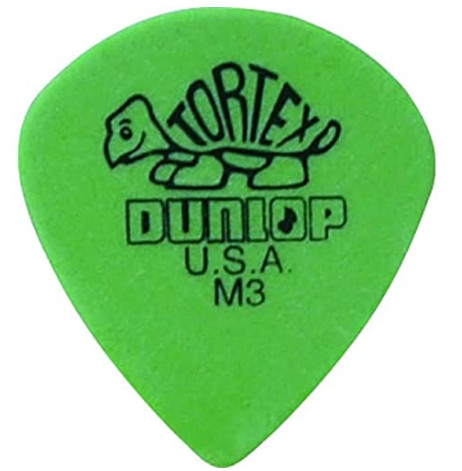 Dunlop Tortex M3 guitar pick for enhanced picking accuracy
Dunlop Tortex M3 guitar pick for enhanced picking accuracy
Beyond material and size, each guitar pick possesses unique functional qualities. Let’s delve into the nuances of guitar pick selection, but first, let’s address a common question:
Why Are Guitarists So Picky About Picks?
Let’s be honest, guitarists are detail-oriented about every aspect of their gear. String gauge, brand (even if many are from the same manufacturer…), tuners, fret material – if there’s a choice to be made, guitarists will have opinions.
This meticulousness stems from a valid reason: every component contributes to our tone and playing experience. Guitar picks are extensions of our musical intentions. They are the interface between player and instrument, enabling us to articulate riffs, melodies, and chords, and ultimately shape our sonic identity.
If you’re like many guitarists, experimentation is part of the fun. This explains the collection of multiple delays and a vast array of overdrive pedals. (It’s the justification we use: “different tools for different jobs.” But deep down, we know it’s a wonderful, inspiring, gear-accumulating passion.)
Guitar picks, being relatively inexpensive, are perfect for exploration. Buying a variety pack is a worthwhile investment in discovering your personal preferences.
Exploring Guitar Pick Materials
Guitar picks can be crafted from a surprising range of materials, but certain materials are consistently popular among guitarists.
Celluloid
Celluloid is the classic material associated with traditional tortoise shell picks. Known for producing a brighter tone, celluloid remains a favorite for players seeking a crisp attack.
Nylon
Nylon picks, such as the widely used Dunlop Standard Picks, are prized for their flexibility and the textured grip they often provide. This enhanced grip is a key factor in their popularity.
Acetal (Tortex)
Acetal, the material behind Dunlop Tortex picks and similar brands, is a durable and versatile choice. Many players, including myself, appreciate the slightly textured surface, sometimes enhanced with a powder grip for even greater control. Acetal’s durability ensures picks last longer, making it a practical option.
Ultem
Ultem picks are less common than other materials listed, but they offer unique characteristics. Notably stiff and bright-toned, regardless of thickness, Ultem picks are favored by players seeking articulation and clarity.
Acrylic
Acrylic picks are distinguished by their clear appearance, density, and durability. They can be tinted in virtually any color and often feature textured grips to compensate for their inherently slick surface. Acrylic picks deliver a bright and articulate tone.
Exotic and Unique Guitar Picks
Beyond standard materials, a world of niche and specialized picks exists. Here are a few notable examples:
Purple Plectrums
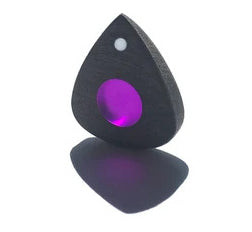 Purple Plectrums thick guitar pick for ergonomic grip
Purple Plectrums thick guitar pick for ergonomic grip
Purple Plectrums stand out for their extreme thickness, ranging from 6mm to 9mm. This substantial thickness provides an exceptionally ergonomic grip, reducing hand fatigue during extended playing sessions. While unconventional, their unique design caters to players prioritizing comfort.
Dragon’s Heart Guitar Picks
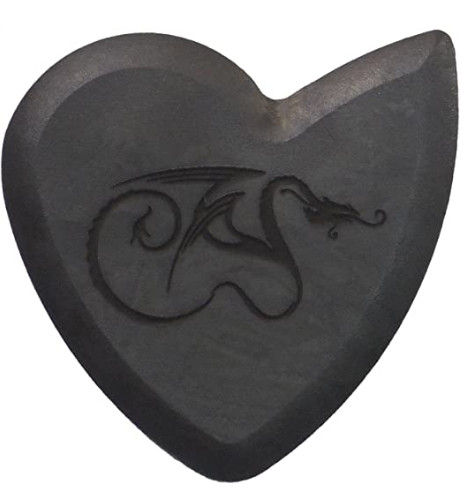 Dragon's Heart guitar pick with multiple playing edges
Dragon's Heart guitar pick with multiple playing edges
Dragon’s Heart picks boast a unique shape and 3mm thickness, promising an impressive 1000-hour lifespan. Their design incorporates multiple playing edges: a sharp point for precision and two rounded variations, offering tonal versatility within a single pick.
Chibson Jumbo Guitar Pick
 Oversized Chibson Jumbo guitar pick for novelty
Oversized Chibson Jumbo guitar pick for novelty
The Chibson Jumbo Guitar Pick is less about practical playing and more of a novelty item. Its oversized nature is immediately apparent, making it a conversation starter and a fun addition to any guitarist’s collection, though perhaps not for everyday use.
Understanding Guitar Pick Sizes (Thickness)
Guitar picks are available in a wide range of thicknesses, each influencing tone and playability. Like material, pick thickness significantly affects the sound produced. The interplay of material and thickness creates a vast spectrum of tonal possibilities, even if the differences are sometimes subtle.
Pick thickness is generally categorized into four groups: Thin, Medium, Heavy, and Extra Heavy.
- Thin picks: .40mm to .60mm
- Medium picks: .60mm to .80mm
- Heavy picks: .80mm to 1.20mm
- Extra Heavy picks: Above 1.20mm
A general principle is that thinner picks produce a less full-bodied tone. A .40mm pick will sound brighter and less substantial compared to thicker options. Acoustic guitarists often employ thin picks for strumming, particularly when aiming for a sound that cuts through a mix.
Conversely, thicker picks contribute to a fuller, more robust tone. While material still influences brightness, thicker picks generally exhibit less perceived brightness than thinner counterparts.
These tonal differences arise from how picks interact with the guitar strings. A thinner pick, being more flexible, cannot displace the strings as much as a thicker, stiffer pick. The thin pick yields to the string’s resistance, while a thicker pick transfers more energy to the string. Experiment with thin and thick picks to appreciate the sonic variations firsthand.
Both extremely thin and extremely thick picks can present challenges to playing speed. Thin picks, due to their flexibility, can hinder speed as they flex and give way to string resistance.
Conversely, very thick picks introduce more material at the point of contact with the strings. Moving a greater mass across the strings requires more effort, potentially slowing down picking speed. Consider that a 1.50mm Clayton pick, uniform in thickness, presents more resistance than a thinner pick.
However, pick design can mitigate these effects. The Purple Plectrum, despite its thickness, features a sharp point to address speed concerns. Personal preference plays a crucial role; many guitarists find a middle ground. For example, .88mm picks offer a balance of stability and speed.
Exploring Different Guitar Pick Shapes
Beyond material and thickness, guitar picks come in various shapes, further expanding the options available to players.
Classic/Standard Pick Shape
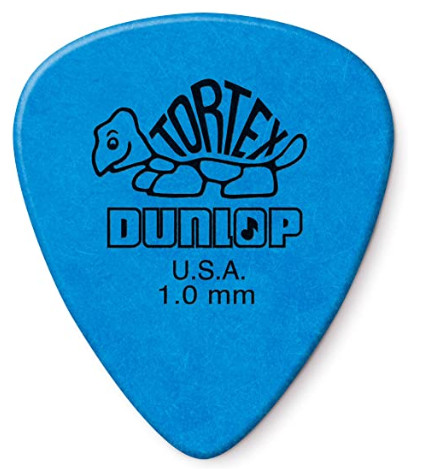 Standard shaped Tortex guitar pick for versatile playing
Standard shaped Tortex guitar pick for versatile playing
The Classic or Standard pick shape is likely the most familiar. It fits comfortably between the thumb and index finger, allowing for adjustments in grip to achieve varying degrees of control. Its versatility makes it suitable for diverse playing styles.
Jazz Pick Shape
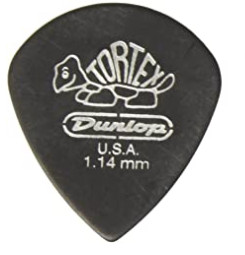 Jazz shaped Tortex guitar pick for precision picking
Jazz shaped Tortex guitar pick for precision picking
Despite the name, Jazz picks are popular among players across genres, including metal. Characterized by a sharper point and a smaller overall size (roughly 75% of a standard pick), Jazz picks are favored for their exceptional picking accuracy. The smaller size may require an adjustment period for players accustomed to larger picks.
Tri-Tip/Triangle Pick Shape
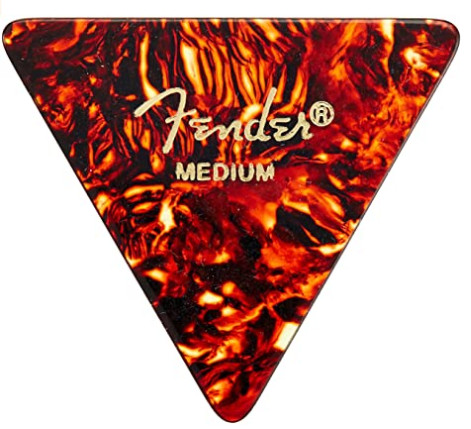 Triangle shaped Fender guitar pick for comfortable grip
Triangle shaped Fender guitar pick for comfortable grip
For players who find standard or jazz picks too small, Tri-Tip or Triangle picks offer a larger gripping surface. The increased size provides a more substantial and comfortable feel, particularly for players with larger hands or those seeking a more secure grip.
Triangle picks are also available in more rounded variations, such as the Dunlop Ultex Triangle, offering a different tonal and playing experience.
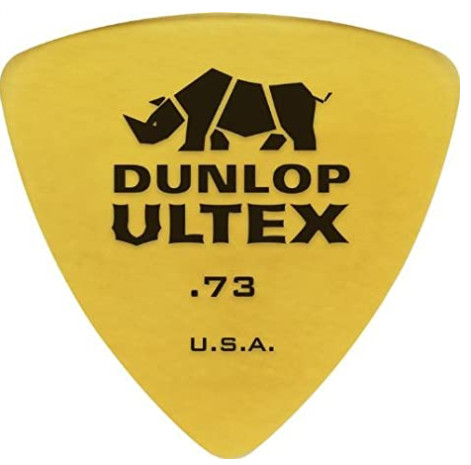 Rounded triangle Dunlop Ultex guitar pick
Rounded triangle Dunlop Ultex guitar pick
How To Choose Your Best Guitar Pick
Finding the ideal guitar pick often involves a process of experimentation. Years of trying different picks, as I did, is not uncommon. Working at a music store provided ample opportunity to sample various options. I encourage you to actively try different picks, experimenting with both electric and acoustic guitars.
In the past, I even carried two distinct picks to gigs – a lighter gauge for acoustic and a heavier one for electric. However, if you’re looking for a starting point, here are some recommendations based on common playing scenarios.
While pick selection is largely subjective, certain pick characteristics are objectively better suited for specific playing styles.
Best Guitar Pick for Shredding?
For fast, articulate playing (“shredding”), a firmer pick in the .80mm to 1.00mm range is generally recommended. A sharper point enhances picking accuracy. Many lead guitarists favor Jazz or standard-sized picks for shredding applications.
Best Guitar Pick for Acoustic Guitar?
For acoustic strumming, versatility is key. If you’re a heavy-handed strummer, consider staying below .80mm to avoid excessive boominess. Lighter strummers might avoid going below that same thickness for adequate body. For average strumming intensity, a wider range of picks will work well.
A good starting point for acoustic guitarists is the .66mm to .73mm range. The .73mm often strikes a pleasing balance of brightness and body for acoustic playing.
Best Guitar Pick for Joint Pain or Arthritis?
Guitarists sometimes experience wrist pain or arthritis. Preventative measures like warm-up stretches are important, but pick choice can also play a role.
Ergonomic picks that require less gripping force are beneficial. Triangle, Dragon’s Heart, and Purple Plectrum picks, due to their larger size, can be easier to hold and reduce hand strain. Some of these larger picks still incorporate sharp points for picking precision.
Best Guitar Pick for Grip?
If dropped picks are a frequent issue, consider larger picks or picks with textured grips.
Textured grip picks provide a sandpaper-like feel, offering exceptional security even with sweaty hands. These picks minimize slippage and maintain consistent control.
Experimentation is Key!
The beauty of guitar picks, unlike more expensive gear, is their affordability and ease of experimentation. Mixed packs offering various materials, sizes, and shapes are readily available.
Dedicate a week to trying a new pick, especially if you play regularly. This allows sufficient time to adapt. While some picks might be immediately dismissed, even those are worth exploring.
Using an unfamiliar pick can spark creativity and inspire new playing approaches. Any deviation from your usual routine can lead to unexpected musical discoveries.
Plus, a surplus of picks is always useful for sharing (or playfully flicking at bandmates).
And remember the guitarist’s adage: “If you pick it, it will never heal.”

